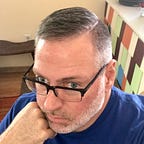Hi Robyn!
I’m not certain but I suspect you might be thinking I’m intending to cast doubt on the sex or gender self-identification of transgender people when I placed the word “female” in double quotation marks.
I admit, that part of my story gets a bit confusing, because Gallup reports numbers for “males” and “females” (their exact terms not mine; see Gallup’s graphics that accompany my story) and we usually talk about transgender “women” and “men.” (“Transgender” is a gender term, unlike “female” and “male,” which are sex terms.) That makes it difficult to view Gallup’s numbers in the context of existing demographic data about LGBT people. The root problem is: Gallup is not following best practices for surveying LGBT populations. (Some widely adopted best practices can be found here.)
I suspect Gallup is doing this to ‘meet people where they are’ — they are, after all, interviewing 340,000 people and I think we can assume not all those people ken the distinction between “sex” and “gender.” But still, the terms they use in surveys can make it challenging to describe their results using more careful language.
Also, let me clear: I use double quotation marks for two purposes only:
- To indicate when I’ve borrowed words from another writer (to avoid charges of plagiarism. I am, after all, an academic.)
- To distinguish a word within a sentence so that it is not viewed as part of a sentence’s syntax. I did this above in my first sentence when I put the word “female” in quotes. (And I just did it again there).
If I wanted to cast doubt or express irony, I would have used single quotes. (Though, I recognize conventions for use and meaning of single and double quotes is culturally bounded. The Brits do it the exact reverse of what I’m describing here). Plus, given what I do for a living, I’m not likely to be casting doubt on the sex or gender self-identification of transgender (or any other) people…
So when I wrote “transgender ‘females’ and ‘males’” — and I’m using double quotes here to indicate that I’m quoting exact words from my story and single quotes to indicate that some of the quoted words were in double quotes in the original — I wanted to indicate that those sex terms (“female” and “male”) were Gallup’s, not mine. But also to allow for the possibility that some Gallup poll respondents who were transgender may have elected to self-identify to a pollster using the options provided (even if they viewed them as inaccurate or insufficient) if only so they would be accounted for in the data. And that other transgender people might have simply identified themselves as “female” or “male” to the pollsters without giving the question a second thought — because they identify as “female” or “male.”
But my larger point stands: if most surveys have found there are more lesbians than gay men, Gallup’s report that there are more adult LGBT “females” than “males” in the U.S. is likely due to lumping together bisexual and transgender people with lesbians and gay men. Since many more women than men (those are the terms used by other surveys) identify as bisexual, it’s likely bisexual women are what accounts for Gallup’s LGBT ‘gender’ gap (it’s not really a gender gap; it’s sex gap. But I’m also trying to ‘meet people where they are’ — Medium is, after all, a popular medium, not a scholarly one.)
But I also see that these subtleties of language and punctuation might not be obvious in my story. I will add a clarifying note.
Michael J. Murphy, Ph.D., is Associate Professor of Gender and Sexuality Studies at the University of Illinois Springfield. He is the author of many book chapters, and encyclopedia and journal articles. Most recently he edited Living Out Loud: An Introduction to LGBTQ History, Society, and Culture (Routledge, 2019). He lives in St. Louis with his husband.
